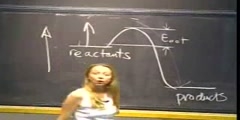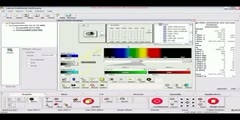Lec 4 - Coping with Smallness and Scanning Probe Microscopy
"Lec 4 - Coping with Smallness and Scanning Probe Microscopy" Freshman Organic Chemistry (CHEM 125) This lecture asks whether it is possible to confirm the reality of bonds by seeing or feeling them. It first describes the work of "clairvoyant" charlatans from the beginning of the twentieth century, who claimed to "see" details of atomic and molecular structure, in order to discuss proper bases for scientific belief. It then shows that the molecular scale is not inconceivably small, and that Newton and Franklin performed simple experiments that measure such small distances. In the last 25 years various realizations of Scanning Probe Microscopy have enabled chemists to "feel" individual molecules and atoms, but not bonds. 00:00 - Chapter 1. Early Attempts to Visualize Atoms: Clairvoyance 15:39 - Chapter 2. Measuring Small Distances: Newton's Rings and Franklin's Oil-Water Experiment 29:51 - Chapter 3. Scanning Probe Microscopy: Feeling out Electron Pairs 41:23 - Chapter 4. Resonance Structures for H, C, N, O Isomers Complete course materials are available at the Open Yale Courses website: http://open.yale.edu/courses This course was recorded in Fall 2008.
Video is embedded from external source so embedding is not available.
Video is embedded from external source so download is not available.
Channels: Chemistry (General)
Tags: Atomic Force Microscopy AFM STM SNOM
Uploaded by: yalefreshorganic ( Send Message ) on 05-09-2012.
Duration: 50m 2s
Here is the next lecture for this course
Lec 1 - Tissue Preparation for Light Micr ...
12:19 | 5995 viewsWhat is Fluorescent Confocal Microscopy?
02:37 | 2848 viewsConfocal microscopy
01:58 | 2864 viewsLec 20 - EE290f Photo-Emission Electron ...
01:21:02 | 3027 viewsLec 23 - EE290f Zone Plate Microscopy an ...
01:23:03 | 2441 viewsLec 25 - EE290f Biological X-Ray Microsc ...
01:20:12 | 2696 viewsChemical Science-Atomic Theory of Matter ...
41:59 | 24368 viewsCell divison video under flourescent micr ...
00:31 | 25910 viewsConfocal Microscopy training
07:11 | 14531 viewsThe Process of Phagocytosis Under Microscopy
00:23 | 18429 viewsPhysics Lab Demo 10: Induced Electromagne ...
01:37 | 16656 viewsChemistry Tutorial 3.01b : Weight Average ...
04:54 | 7991 viewsAtomic Absorption Spectroscopy
07:36 | 13005 viewsFlame Atomic Absorption Spectroscopy usin ...
00:60 | 10810 viewsWeapons of Destruction :Atomic & Hydrogen ...
03:35 | 13460 viewsNo content is added to this lecture.
This video is a part of a lecture series from of Yale
Lecture list for this course
Lec 2 - Force Laws, Lewis Structures and Resonance
Lec 3 - Double Minima, Earnshaw's Theorem and Plum-Puddings
Lec 6 - Seeing Bonds by Electron Difference Density
Lec 7 - Quantum Mechanical Kinetic Energy
Lec 8 - One-Dimensional Wave Functions
Lec 9 - Chladni Figures and One-Electron Atoms
Lec 10 - Reality and the Orbital Approximation
Lec 11 - Orbital Correction and Plum-Pudding Molecules
Lec 12 - Overlap and Atom-Pair Bonds
Lec 13 - Overlap and Energy-Match
Lec 14 - Checking Hybridization Theory with XH_3
Lec 15 - Chemical Reactivity: SOMO, HOMO, and LUMO
Lec 16 - Recognizing Functional Groups
Lec 17 - Reaction Analogies and Carbonyl Reactivity
Lec 18 - Amide, Carboxylic Acid and Alkyl Lithium
Lec 19 - Oxygen and the Chemical Revolution (Beginning to 1789)
Lec 20 - Rise of the Atomic Theory (1790-1805)
Lec 21 - Berzelius to Liebig and Wöhler (1805-1832)
Lec 22 - Radical and Type Theories (1832-1850)
Lec 23 - Valence Theory and Constitutional Structure (1858)
Lec 24 - Determining Chemical Structure by Isomer Counting (1869)
Lec 25 - Models in 3D Space (1869-1877); Optical Isomers
Lec 26 - Van't Hoff's Tetrahedral Carbon and Chirality
Lec 27 - Communicating Molecular Structure in Diagrams and Words
Lec 28 - Stereochemical Nomenclature; Racemization and Resolution
Lec 29 - Preparing Single Enantiomers and the Mechanism of Optical Rotation
Lec 30 - Esomeprazole as an Example of Drug Testing and Usage
Lec 31 - Preparing Single Enantiomers and Conformational Energy
Lec 32 - Stereotopicity and Baeyer Strain Theory
Lec 33 - Conformational Energy and Molecular Mechanics
Lec 34 - Sharpless Oxidation Catalysts and the Conformation of Cycloalkanes
Lec 35 - Understanding Molecular Structure and Energy through Standard Bonds
Lec 36 - Bond Energies, the Boltzmann Factor and Entropy
Lec Last - Potential Energy Surfaces, Transition State Theory and Reaction Mechanism
















